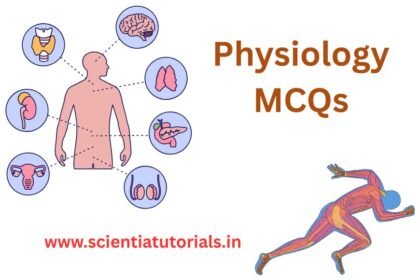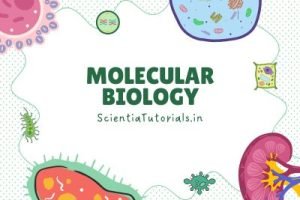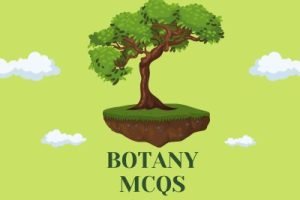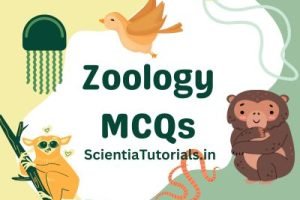
Physiology MCQs
🫀 Physiology MCQs – Part 1 (Q1–Q25)
Q1. The functional unit of the kidney is:
A) Nephron
B) Glomerulus
C) Collecting duct
D) Loop of Henle
✅ Answer: A) Nephron
Explanation: Nephron filters blood, reabsorbs nutrients, and produces urine. Glomerulus, loop, and ducts are parts of the nephron.
Q2. Which part of the nephron is primarily responsible for water reabsorption?
A) Proximal tubule
B) Distal tubule
C) Collecting duct
D) Loop of Henle
✅ Answer: D) Loop of Henle
Explanation: Descending limb is water-permeable; ascending limb is salt-permeable. Collecting duct also reabsorbs water under ADH.
Q3. The hormone that regulates sodium reabsorption in the kidney is:
A) ADH
B) Aldosterone
C) Cortisol
D) Insulin
✅ Answer: B) Aldosterone
Explanation: Aldosterone (adrenal cortex) ↑ Na⁺ reabsorption, K⁺ secretion. ADH regulates water.
Q4. Oxygen is primarily transported in blood as:
A) Dissolved in plasma
B) Bound to hemoglobin
C) As bicarbonate
D) As free radicals
✅ Answer: B) Bound to hemoglobin
Explanation: ~98% of O₂ carried by hemoglobin. Only ~2% dissolved in plasma.
Q5. The Bohr effect describes:
A) CO₂ decreases O₂ release
B) Increased CO₂ enhances O₂ release from hemoglobin
C) O₂ increases hemoglobin’s affinity for CO₂
D) Bicarbonate buffering
✅ Answer: B)
Explanation: High CO₂/H⁺ → reduced hemoglobin affinity → O₂ release to tissues.
Q6. The pacemaker of the heart is:
A) AV node
B) SA node
C) Bundle of His
D) Purkinje fibers
✅ Answer: B) SA node
Explanation: SA node initiates action potentials → sets heart rhythm.
Q7. Normal human blood pH is:
A) 6.8–7.0
B) 7.35–7.45
C) 7.8–8.0
D) 6.0–6.5
✅ Answer: B) 7.35–7.45
Explanation: Slightly alkaline; maintained by buffer systems + respiration + kidneys.
Q8. Erythropoietin, which stimulates RBC production, is secreted by:
A) Liver
B) Kidney
C) Bone marrow
D) Spleen
✅ Answer: B) Kidney
Explanation: Kidney hypoxia → ↑ EPO → stimulates bone marrow erythropoiesis.
Q9. The pulmonary surfactant reduces:
A) Blood flow
B) Surface tension in alveoli
C) Gas diffusion
D) Hemoglobin binding
✅ Answer: B)
Explanation: Surfactant lowers alveolar surface tension, prevents collapse.
Q10. Normal resting heart rate in adults is:
A) 30–40 bpm
B) 60–100 bpm
C) 120–150 bpm
D) 40–50 bpm
✅ Answer: B) 60–100 bpm
Explanation: Typical adult resting HR range. Trained athletes may be lower.
Q11. Which valve prevents backflow from left ventricle to left atrium?
A) Tricuspid valve
B) Pulmonary valve
C) Mitral (bicuspid) valve
D) Aortic valve
✅ Answer: C) Mitral valve
Explanation: Mitral valve prevents backflow between left atrium ↔ ventricle.
Q12. The primary pacemaker potential is generated by:
A) Na⁺ leak channels
B) K⁺ leak channels
C) Ca²⁺ influx
D) Cl⁻ channels
✅ Answer: A) Na⁺ leak channels
Explanation: SA node depolarization due to slow Na⁺ influx, then Ca²⁺.
Q13. Which vitamin is essential for clotting factor synthesis?
A) Vitamin A
B) Vitamin C
C) Vitamin K
D) Vitamin D
✅ Answer: C) Vitamin K
Explanation: Vitamin K needed for clotting factor II, VII, IX, X synthesis.
Q14. The primary digestive enzyme in saliva is:
A) Pepsin
B) Amylase
C) Lipase
D) Trypsin
✅ Answer: B) Amylase (ptyalin)
Explanation: Begins starch → maltose digestion in mouth.
Q15. Bile salts aid digestion of:
A) Proteins
B) Lipids
C) Carbohydrates
D) Nucleic acids
✅ Answer: B) Lipids
Explanation: Bile salts emulsify fats → ↑ surface area for lipase.
Q16. Which hormone stimulates secretion of gastric acid?
A) Secretin
B) Gastrin
C) CCK
D) GIP
✅ Answer: B) Gastrin
Explanation: Gastrin (from stomach G-cells) ↑ HCl secretion.
Q17. The largest digestive gland is:
A) Stomach
B) Liver
C) Pancreas
D) Gallbladder
✅ Answer: B) Liver
Explanation: Liver secretes bile, processes nutrients, detoxifies.
Q18. The enzyme that digests proteins in the stomach is:
A) Trypsin
B) Pepsin
C) Lipase
D) Maltase
✅ Answer: B) Pepsin
Explanation: Pepsin (from pepsinogen + HCl) digests proteins → peptides.
Q19. The pancreatic enzyme that digests starch is:
A) Pepsin
B) Trypsin
C) Amylase
D) Lipase
✅ Answer: C) Amylase
Explanation: Pancreatic amylase continues starch digestion into maltose.
Q20. Which ion is essential for muscle contraction?
A) Sodium
B) Potassium
C) Calcium
D) Chloride
✅ Answer: C) Calcium
Explanation: Ca²⁺ binds troponin → exposes myosin binding sites.
Q21. The neurotransmitter at the neuromuscular junction is:
A) Dopamine
B) Acetylcholine
C) Serotonin
D) GABA
✅ Answer: B) Acetylcholine
Explanation: ACh released → depolarizes skeletal muscle → contraction.
Q22. The refractory period in nerve impulse is due to:
A) Sodium channels closed
B) Potassium channels closed
C) Sodium channels inactivated
D) Chloride influx
✅ Answer: C) Sodium channels inactivated
Explanation: Na⁺ channels temporarily inactivated → no new AP.
Q23. Which part of the brain regulates breathing and heart rate?
A) Cerebrum
B) Cerebellum
C) Medulla oblongata
D) Thalamus
✅ Answer: C) Medulla oblongata
Explanation: Medulla houses cardiac and respiratory centers.
Q24. The hormone insulin lowers blood glucose by:
A) Promoting glycogen breakdown
B) Increasing glucose uptake by cells
C) Inhibiting glycolysis
D) Stimulating gluconeogenesis
✅ Answer: B) Increasing glucose uptake
Explanation: Insulin promotes cellular uptake + glycogenesis.
Q25. Which gland is called the “master gland”?
A) Thyroid
B) Adrenal
C) Pituitary
D) Pancreas
✅ Answer: C) Pituitary gland
Explanation: Pituitary secretes tropic hormones regulating other glands.
🫀 Physiology MCQs – Part 2 (Q26–Q50)
Q26. The hormone secreted by the pineal gland is:
A) Melatonin
B) Serotonin
C) Cortisol
D) Aldosterone
✅ Answer: A) Melatonin
Explanation: Melatonin regulates circadian rhythm and sleep–wake cycle.
Q27. Which hormone increases blood calcium levels?
A) Calcitonin
B) Parathyroid hormone (PTH)
C) Insulin
D) Aldosterone
✅ Answer: B) PTH
Explanation: PTH ↑ bone resorption, ↑ renal calcium reabsorption, ↑ vitamin D activation.
Q28. Which hormone decreases blood calcium levels?
A) PTH
B) Calcitonin
C) Cortisol
D) Glucagon
✅ Answer: B) Calcitonin
Explanation: Calcitonin (thyroid C cells) inhibits bone resorption, lowering Ca²⁺.
Q29. Which part of the nephron is most active in glucose reabsorption?
A) Loop of Henle
B) Distal convoluted tubule
C) Proximal convoluted tubule
D) Collecting duct
✅ Answer: C) Proximal convoluted tubule
Explanation: PCT reabsorbs 100% glucose and amino acids (via active transport).
Q30. The hormone secreted by the adrenal medulla is:
A) Cortisol
B) Aldosterone
C) Epinephrine (adrenaline)
D) Androgens
✅ Answer: C) Epinephrine
Explanation: Adrenal medulla secretes epinephrine and norepinephrine, fight-or-flight.
Q31. The main function of hemoglobin is to:
A) Carry CO₂
B) Carry O₂
C) Act as a buffer
D) Transport hormones
✅ Answer: B) Carry O₂
Explanation: Hemoglobin carries 98% of O₂ and ~20% of CO₂ (as carbaminohemoglobin).
Q32. In humans, most carbon dioxide is transported as:
A) Dissolved in plasma
B) Carbaminohemoglobin
C) Bicarbonate ions
D) Free gas
✅ Answer: C) Bicarbonate ions
Explanation: ~70% CO₂ transported as HCO₃⁻ in plasma.
Q33. The cardiac output is defined as:
A) Heart rate × Stroke volume
B) End-diastolic volume – End-systolic volume
C) Heart rate × Blood pressure
D) Systolic + Diastolic pressure
✅ Answer: A)
Explanation: Cardiac output = HR × SV, average ~5 L/min in adults.
Q34. Which wave in ECG represents atrial depolarization?
A) P wave
B) QRS complex
C) T wave
D) U wave
✅ Answer: A) P wave
Explanation: P wave = atrial depolarization; QRS = ventricular depolarization; T = ventricular repolarization.
Q35. Which blood group is called the universal donor?
A) AB+
B) O+
C) O−
D) AB−
✅ Answer: C) O−
Explanation: O− has no antigens, can be transfused to all groups.
Q36. Which blood group is called the universal recipient?
A) O+
B) AB+
C) AB−
D) B+
✅ Answer: B) AB+
Explanation: AB+ has all antigens, no antibodies → receives from all groups.
Q37. Which vitamin deficiency causes night blindness?
A) Vitamin A
B) Vitamin B12
C) Vitamin D
D) Vitamin K
✅ Answer: A) Vitamin A
Explanation: Vitamin A needed for rhodopsin in retina.
Q38. Which vitamin deficiency causes rickets in children?
A) Vitamin A
B) Vitamin D
C) Vitamin E
D) Vitamin K
✅ Answer: B) Vitamin D
Explanation: Vitamin D deficiency → poor bone mineralization → rickets.
Q39. Which part of the brain controls posture and balance?
A) Cerebrum
B) Cerebellum
C) Medulla
D) Thalamus
✅ Answer: B) Cerebellum
Explanation: Cerebellum coordinates balance, posture, fine motor control.
Q40. The sympathetic nervous system mainly uses:
A) Dopamine
B) Acetylcholine
C) Norepinephrine
D) GABA
✅ Answer: C) Norepinephrine
Explanation: Sympathetic nerves → NE at effector organs (except sweat glands).
Q41. The parasympathetic nervous system uses:
A) Acetylcholine
B) Norepinephrine
C) Dopamine
D) Serotonin
✅ Answer: A) Acetylcholine
Explanation: Parasympathetic nerves → ACh at ganglia + effector organs.
Q42. Which part of the nephron is impermeable to water?
A) Descending limb of loop of Henle
B) Ascending limb of loop of Henle
C) Proximal tubule
D) Collecting duct
✅ Answer: B) Ascending limb
Explanation: Ascending limb actively pumps salts but is impermeable to water.
Q43. Which pancreatic hormone increases blood glucose?
A) Insulin
B) Glucagon
C) Somatostatin
D) Amylin
✅ Answer: B) Glucagon
Explanation: Glucagon promotes glycogenolysis + gluconeogenesis.
Q44. Which hormone is secreted by the posterior pituitary?
A) Oxytocin
B) Growth hormone
C) ACTH
D) TSH
✅ Answer: A) Oxytocin (and ADH)
Explanation: Posterior pituitary stores/releases ADH and oxytocin made in hypothalamus.
Q45. The respiratory center is sensitive to:
A) Oxygen levels in blood
B) CO₂ and H⁺ levels
C) Hemoglobin concentration
D) Nitrogen pressure
✅ Answer: B) CO₂ and H⁺
Explanation: Respiratory drive mainly from PaCO₂ and pH (chemoreceptors).
Q46. Which heart sound corresponds to closure of AV valves?
A) First (S1)
B) Second (S2)
C) Third (S3)
D) Fourth (S4)
✅ Answer: A) First (S1)
Explanation: S1 = closure of mitral/tricuspid valves (start systole).
Q47. Which hormone stimulates milk ejection?
A) Prolactin
B) Oxytocin
C) Estrogen
D) Progesterone
✅ Answer: B) Oxytocin
Explanation: Oxytocin causes milk letdown reflex. Prolactin stimulates milk production.
Q48. Which hormone stimulates uterine contractions during labor?
A) Estrogen
B) Oxytocin
C) Relaxin
D) Progesterone
✅ Answer: B) Oxytocin
Explanation: Oxytocin causes uterine contractions in childbirth.
Q49. The normal tidal volume in adult humans is about:
A) 100 ml
B) 500 ml
C) 1500 ml
D) 2500 ml
✅ Answer: B) 500 ml
Explanation: Tidal volume = air exchanged in normal breath.
Q50. Vital capacity of the lungs is defined as:
A) Tidal volume + residual volume
B) IRV + ERV + TV
C) TV + RV
D) ERV + RV
✅ Answer: B) IRV + ERV + TV
Explanation: Vital capacity = inspiratory reserve + expiratory reserve + tidal volume.
🫀 Physiology MCQs – Part 3 (Q51–Q75)
Q51. Which blood cells are responsible for immune response?
A) Red blood cells
B) Platelets
C) White blood cells
D) Epithelial cells
✅ Answer: C) White blood cells
Explanation: WBCs (lymphocytes, neutrophils, etc.) defend against pathogens.
Q52. Which blood component plays the main role in clotting?
A) WBCs
B) Platelets
C) Plasma proteins
D) RBCs
✅ Answer: B) Platelets
Explanation: Platelets + clotting factors form a hemostatic plug.
Q53. Which hormone regulates circadian rhythm?
A) Cortisol
B) Melatonin
C) Insulin
D) Thyroxine
✅ Answer: B) Melatonin
Explanation: Pineal gland releases melatonin at night → sleep regulation.
Q54. Which vitamin is necessary for absorption of calcium in intestines?
A) Vitamin A
B) Vitamin C
C) Vitamin D
D) Vitamin K
✅ Answer: C) Vitamin D
Explanation: Vitamin D enhances calcium absorption from intestine.
Q55. Which gland regulates basal metabolic rate (BMR)?
A) Pituitary
B) Adrenal
C) Thyroid
D) Pancreas
✅ Answer: C) Thyroid
Explanation: Thyroxine (T₃/T₄) increases basal metabolism.
Q56. Hypersecretion of growth hormone in adults causes:
A) Gigantism
B) Dwarfism
C) Acromegaly
D) Rickets
✅ Answer: C) Acromegaly
Explanation: Excess GH after epiphyseal closure → acromegaly (enlarged extremities).
Q57. Hyposecretion of thyroxine in childhood causes:
A) Goiter
B) Cretinism
C) Myxedema
D) Acromegaly
✅ Answer: B) Cretinism
Explanation: Childhood hypothyroidism → mental and growth retardation.
Q58. Which hormone stimulates glycogen breakdown in the liver?
A) Insulin
B) Glucagon
C) Aldosterone
D) ADH
✅ Answer: B) Glucagon
Explanation: Glucagon stimulates glycogenolysis + gluconeogenesis.
Q59. The hormone cortisol is secreted by:
A) Adrenal medulla
B) Adrenal cortex
C) Pancreas
D) Pituitary
✅ Answer: B) Adrenal cortex
Explanation: Cortisol = glucocorticoid → stress hormone, ↑ blood glucose.
Q60. Which part of the brain regulates thirst and hunger?
A) Medulla
B) Hypothalamus
C) Cerebellum
D) Hippocampus
✅ Answer: B) Hypothalamus
Explanation: Hypothalamus regulates hunger, thirst, body temp, endocrine system.
Q61. Which part of the brain is associated with memory?
A) Cerebellum
B) Hypothalamus
C) Hippocampus
D) Medulla
✅ Answer: C) Hippocampus
Explanation: Hippocampus (limbic system) stores long-term memory.
Q62. The neurotransmitter involved in Parkinson’s disease is:
A) Serotonin
B) Acetylcholine
C) Dopamine
D) GABA
✅ Answer: C) Dopamine
Explanation: Dopamine deficiency in substantia nigra → Parkinson’s disease.
Q63. Which neurotransmitter is mainly inhibitory in CNS?
A) Acetylcholine
B) Dopamine
C) GABA
D) Glutamate
✅ Answer: C) GABA
Explanation: GABA = main inhibitory neurotransmitter. Glutamate = excitatory.
Q64. Which neurotransmitter is associated with mood regulation and depression?
A) Dopamine
B) Serotonin
C) Epinephrine
D) Acetylcholine
✅ Answer: B) Serotonin
Explanation: Low serotonin levels → linked to depression, mood disorders.
Q65. Which hormone is called the “fight-or-flight” hormone?
A) Insulin
B) Epinephrine (adrenaline)
C) Glucagon
D) Thyroxine
✅ Answer: B) Epinephrine
Explanation: Secreted by adrenal medulla → increases HR, BP, blood glucose.
Q66. The largest white blood cells are:
A) Lymphocytes
B) Monocytes
C) Neutrophils
D) Eosinophils
✅ Answer: B) Monocytes
Explanation: Monocytes are largest WBCs, transform into macrophages.
Q67. Which blood cells release histamine during allergic reactions?
A) Neutrophils
B) Eosinophils
C) Basophils
D) Monocytes
✅ Answer: C) Basophils
Explanation: Basophils and mast cells release histamine, heparin in allergies.
Q68. Which ion is essential for blood clotting?
A) Na⁺
B) Ca²⁺
C) K⁺
D) Cl⁻
✅ Answer: B) Ca²⁺
Explanation: Calcium required for activation of clotting factors.
Q69. The hormone secreted during “long-term stress” is:
A) Epinephrine
B) Norepinephrine
C) Cortisol
D) Insulin
✅ Answer: C) Cortisol
Explanation: Cortisol (glucocorticoid) mobilizes energy stores, suppresses immunity.
Q70. Which part of the eye regulates the amount of light entering?
A) Cornea
B) Iris
C) Lens
D) Retina
✅ Answer: B) Iris
Explanation: Iris adjusts pupil size → regulates light entry.
Q71. Which photoreceptors are responsible for color vision?
A) Rods
B) Cones
C) Bipolar cells
D) Ganglion cells
✅ Answer: B) Cones
Explanation: Cones = color vision, daylight vision; Rods = dim light, B&W.
Q72. The blind spot in the eye occurs at:
A) Macula
B) Fovea
C) Optic disc
D) Retina periphery
✅ Answer: C) Optic disc
Explanation: No photoreceptors at optic disc where optic nerve exits.
Q73. Which structure of the ear maintains balance and equilibrium?
A) Cochlea
B) Semicircular canals
C) Tympanic membrane
D) Ossicles
✅ Answer: B) Semicircular canals
Explanation: Semicircular canals detect angular motion, balance.
Q74. The receptor for hearing is located in:
A) Tympanic membrane
B) Organ of Corti
C) Eustachian tube
D) Semicircular canal
✅ Answer: B) Organ of Corti
Explanation: Organ of Corti (in cochlea) → hair cells detect sound waves.
Q75. The hormone prolactin is secreted by:
A) Anterior pituitary
B) Posterior pituitary
C) Thyroid
D) Adrenal gland
✅ Answer: A) Anterior pituitary
Explanation: Prolactin from anterior pituitary → stimulates milk production.
🫀 Physiology MCQs – Part 4 (Q76–Q100)
Q76. Which hormone is secreted in response to high blood glucose?
A) Insulin
B) Glucagon
C) Epinephrine
D) Cortisol
✅ Answer: A) Insulin
Explanation: Insulin lowers blood glucose by stimulating uptake + glycogenesis.
Q77. Which hormone increases reabsorption of water in kidneys?
A) Oxytocin
B) ADH (Vasopressin)
C) Aldosterone
D) PTH
✅ Answer: B) ADH
Explanation: ADH increases aquaporin channels in collecting ducts → more water reabsorbed.
Q78. Which muscle type is involuntary and non-striated?
A) Skeletal
B) Cardiac
C) Smooth
D) All muscle types
✅ Answer: C) Smooth
Explanation: Smooth muscle = involuntary, non-striated (walls of gut, vessels).
Q79. Which ion initiates neurotransmitter release at synapses?
A) Na⁺
B) K⁺
C) Ca²⁺
D) Cl⁻
✅ Answer: C) Ca²⁺
Explanation: Presynaptic Ca²⁺ influx triggers neurotransmitter vesicle fusion.
Q80. The hormone secreted in response to low blood glucose is:
A) Insulin
B) Glucagon
C) Calcitonin
D) Thyroxine
✅ Answer: B) Glucagon
Explanation: Glucagon promotes glycogenolysis + gluconeogenesis.
Q81. Normal human body temperature is:
A) 36°C
B) 37°C
C) 38.5°C
D) 35°C
✅ Answer: B) 37°C
Explanation: Average physiological temperature = 37°C (98.6°F).
Q82. Which part of the nephron is sensitive to ADH?
A) Proximal tubule
B) Loop of Henle
C) Collecting duct
D) Ascending limb
✅ Answer: C) Collecting duct
Explanation: ADH acts on collecting duct → increases water permeability.
Q83. Which protein carries oxygen in muscles?
A) Hemoglobin
B) Myoglobin
C) Actin
D) Tropomyosin
✅ Answer: B) Myoglobin
Explanation: Myoglobin stores O₂ in muscle cells for rapid use.
Q84. The main function of hemoglobin’s heme group is to bind:
A) CO₂
B) O₂
C) Glucose
D) HCO₃⁻
✅ Answer: B) O₂
Explanation: Heme (with Fe²⁺) binds oxygen molecules.
Q85. The oxygen dissociation curve of hemoglobin is:
A) Linear
B) Sigmoidal
C) Hyperbolic
D) Exponential
✅ Answer: B) Sigmoidal
Explanation: Sigmoidal curve due to cooperative binding of O₂.
Q86. Which hormone is responsible for “fight-or-flight” response?
A) Insulin
B) Epinephrine
C) Cortisol
D) Glucagon
✅ Answer: B) Epinephrine
Explanation: Adrenal medulla secretes epinephrine → ↑HR, BP, glucose.
Q87. Which part of the brain controls voluntary movement?
A) Medulla
B) Cerebellum
C) Cerebrum (motor cortex)
D) Hypothalamus
✅ Answer: C) Cerebrum (motor cortex)
Explanation: Motor cortex in frontal lobe controls voluntary movements.
Q88. Which photoreceptor in the retina is responsible for vision in dim light?
A) Cones
B) Rods
C) Bipolar cells
D) Ganglion cells
✅ Answer: B) Rods
Explanation: Rods = dim-light vision (night vision). Cones = color vision.
Q89. Which taste is detected by the tip of the tongue?
A) Bitter
B) Sweet
C) Sour
D) Salty
✅ Answer: B) Sweet
Explanation: Taste map: tip = sweet, sides = sour/salty, back = bitter (though modern research shows taste receptors are distributed).
Q90. Which fluid fills the anterior chamber of the eye?
A) Vitreous humor
B) Aqueous humor
C) Synovial fluid
D) Plasma
✅ Answer: B) Aqueous humor
Explanation: Aqueous humor nourishes cornea & lens. Vitreous = posterior chamber.
Q91. The semicircular canals detect:
A) Hearing
B) Linear acceleration
C) Angular acceleration
D) Blood pressure
✅ Answer: C) Angular acceleration
Explanation: Semicircular canals detect rotational motion.
Q92. The utricle and saccule detect:
A) Hearing
B) Angular motion
C) Linear acceleration and head position
D) Temperature
✅ Answer: C)
Explanation: Utricle & saccule detect linear motion & gravity.
Q93. The hormone secreted during stress that suppresses immune function is:
A) Insulin
B) Epinephrine
C) Cortisol
D) Growth hormone
✅ Answer: C) Cortisol
Explanation: Cortisol mobilizes glucose but inhibits immune response.
Q94. Which part of the nephron is the site of maximum water reabsorption?
A) Loop of Henle
B) Proximal convoluted tubule
C) Collecting duct
D) Distal tubule
✅ Answer: B) Proximal convoluted tubule
Explanation: PCT reabsorbs ~65% water + nutrients.
Q95. Which brain lobe processes visual information?
A) Frontal
B) Temporal
C) Parietal
D) Occipital
✅ Answer: D) Occipital lobe
Explanation: Occipital cortex = primary visual processing center.
Q96. Which hormone triggers ovulation in females?
A) FSH
B) LH
C) Progesterone
D) Estrogen
✅ Answer: B) LH (Luteinizing hormone)
Explanation: LH surge → ovulation + corpus luteum formation.
Q97. Which hormone maintains pregnancy by supporting the uterine lining?
A) LH
B) Progesterone
C) Estrogen
D) Prolactin
✅ Answer: B) Progesterone
Explanation: Progesterone (from corpus luteum/placenta) maintains endometrium.
Q98. Which hormone is responsible for secondary sexual characteristics in males?
A) Estrogen
B) Progesterone
C) Testosterone
D) LH
✅ Answer: C) Testosterone
Explanation: Testosterone → male puberty, muscle growth, sperm production.
Q99. Which hormone stimulates milk production in females?
A) Oxytocin
B) Prolactin
C) Estrogen
D) Progesterone
✅ Answer: B) Prolactin
Explanation: Prolactin (anterior pituitary) → milk production. Oxytocin → milk ejection.
Q100. The endocrine gland located in the neck, regulating metabolism, is:
A) Pituitary
B) Thyroid
C) Adrenal
D) Pancreas
✅ Answer: B) Thyroid gland
Explanation: Thyroid secretes thyroxine (T₃, T₄) controlling basal metabolic rate.
Physiology MCQs with explanations, solved physiology multiple choice questions for NEET, CBSE ICSE objective physiology questions, physiology MCQs for CUET and CSIR NET, important physiology questions for GATE and DBT BET JRF, physiology multiple choice questions for USMLE and PLAB, practice physiology MCQs for AMC licensing exams, solved physiology questions for SAT Biology Subject Test, GRE Biology Subject Test physiology MCQs, physiology multiple choice questions for BMAT and IMAT exams



